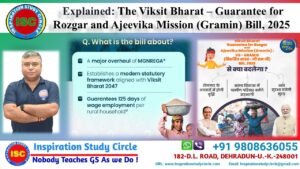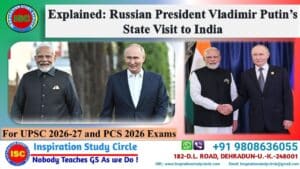
The Viksit Bharat – Guarantee for Rozgar and Ajeevika Mission (Gramin) Bill, 2025
The Viksit Bharat – Guarantee for Rozgar and Ajeevika Mission (Gramin) Bill, 2025 Table of Contents The Viksit Bharat – Guarantee

Union Minister Ashwini Vaishnaw announced that Prime Minister Narendra Modi has approved the formation of the 8th Central Pay Commission. The decision marks a significant step toward revising salary structures and allowances for central government employees and pensioners. Ahead of that, the government has approved the constitution of the 8th Pay Commission so that recommendations can be made in a timely manner and implemented from 2026 onwards.
The Central Pay Commission is a body periodically established to review and recommend changes to the salary structure and allowances for central government employees. This announcement has been welcomed as a positive step for millions of employees and pensioners who stand to benefit from the revised pay scales.
Pay Commission is India’s central government organization set up by the Government of India, which gives its recommendations regarding changes in the salary structure of its employees. It was set up in 1947 and since India’s Independence, seven pay commissions have been set up regularly to review and make recommendations on the work and pay structure of all civil and military divisions of the Government of India.
Headquartered in Delhi (India), the commission is given 18 months from the date of its constitution to make its recommendations.
The first pay commission was established in January 1946 and it submitted its report in May 1947 to the interim government of India. It was under the chairmanship of Srinivasa Varadachariar and had 9 members. The mandate of 1st was to examine and recommend the emolument structure of Civilian employees.
Post-War Pay Committee for the Armed Forces: The First Pay Committee, set up after the 1st Pay Commission, was called “The Post War Pay Committee for the Armed Forces”. The New Pay Code effective from 1 July 1947 was based on the recommendations of this committee. The pensionary benefits were examined by a separate committee called ” Armed Forces Pension Revision Committee (1949–50)”.
The second pay commission was set up in August 1957, 10 years after independence and it gave its report after two years. The chairman of the second pay commission was Jagannath Das.
Raghuramiah Committee: The Departmental Pay Committee, set up after the 2nd Pay Commission, was called, the Raghuramiah Committee (1960), which had service representatives. It examined armed forces emoluments and made recommendations.
The third pay commission set up in April 1970 gave its report in March 1973. The 3rd CPC was the first CPC for Defence Forces. It is for the first time that a Pay Commission has been asked to enquire into the structure of emoluments of both the civilian employees, of the Government and the Armed Forces. There was no bureaucratic interference in proposals made by services.
The commission was of the view that the most practical and equitable method for determining Service pay would be based on fair comparison with the pay rates fixed for the civilian employees of the Central Government. This nexus becomes all the more relevant and desirable when we recall that recruitment to our Armed Forces is voluntary, which means that persons have to be attracted from civilian life. The quality of recruitment to the Armed Forces will be satisfactory only if Service pay is comparable to levels of remuneration in civilian employment. A link between the two is, therefore, inherent in the case of volunteer armed forces.
Constituted in June 1983, its report was given in three phases within four years and the financial burden to the government was ₹ 1282 crore. The chairman of the Fourth Pay Commission was P N Singhal.
Indian National Congress (I) Government, headed by Rajiv Gandhi, in the wake of the 4th CPC implemented the concept of ‘Rank Pay‘ for armed forces officers. Rank Pay affected all officers’ ranks from second lieutenant to brigadier in the army, and equivalent ranks in the Indian Air Force and the Indian Navy. The rank pay became an issue of considerable resentment in the armed forces, and cause of general distrust of the pay commissions, and the Congress I Government.
After a protracted legal struggle High Court, despite many appeals, in a landmark decision declares the ‘rank pay’ concept illegal. In its judgment, the SC notes that the ‘rank pay’ was wrongly deducted from basic pay and ordered re-fixation of pay “with effect from” and not “as on” 1 January 1986.
The notification for setting up the Fifth CPC was issued on 9 April 1994 but started functioning only on 2 May 1994, with the assumption of charge by the Member Secretary. The chairman of the Fifth Pay Commission was Justice S. Ratnavel Pandian. The members were: Suresh Tendulkar, Professor at Delhi School of Economics; and M.K Kaw, IAS.
In comparison, the First CPC had nine members including military members, the Second had six members including a military member, the 3 CPC and 4 CPC had five, but no military member. The fifth had three members, but no military member. After the 1 CPC all pay commissions have had a member secretary, and invariably from the IAS.
The 5 CPC, for the first time, was asked to examine the terms and conditions of the Armed Forces, and make suggestions for what is “considered desirable and feasible”.
The 5 CPC, in its report submitted in January 1997, recommended an increase in posts for Armed Forces personnel in Groups C and D in Central Armed Police Forces (CAPFs) from 10 to 25 percent. For Short Service Commissioned Officers, on completion of their military service, 5 CPC recommended earmarking 25 percent of officer’s post in the CAPFs. These recommendations by the Pay Commission were intended to reduce the defense pension bill; save on training and recruitment costs; provide trained manpower to government departments; and provide soldiers a second career after their term of military engagement.
These recommendations of the Pay Commission were, however, mostly ignored by the Janata Dal (United Front), and BJP Government of Atal Bihari Vajpayee that followed.
In July 2006, the Cabinet approved the setting up of the sixth pay commission. This commission has been set up under Justice B.N.Srikrishna with a timeframe of 18 months.
The cost of hikes in salaries was anticipated to be about ₹ 20,000 crore for a total of 5.5 million government employees as per media speculation on the 6th Pay Commission, the report of which was expected to be handed over in late March/early April 2008.
The employees had threatened to go on a nationwide strike if the government failed to hike their salaries. Reasons for the demand for hikes included rising inflation and rising pay in the private sector due to the forces of Globalization.
The Sixth Pay Commission mainly focused on removing ambiguity concerning various pay scales and mainly focused on reducing the number of pay scales and bringing the idea of pay bands. It recommended for removal of the Group-D cadre.
On 25 September 2013, the Government of India approved the constitution of the 7th Pay Commission. Its recommendations were expected to be implemented with effect from 1 January 2016. Justice A.K Mathur was heading the Seventh Pay Commission, the announcement of which was done on 4 February 2014.
Composition:
Name | Designation | Role in Commission |
Retired Judge, Supreme Court and Retired Chairman, Armed Forces Tribunal | Chairman | |
Vivek Rae | Retd. Secretary, Ministry of Petroleum and Natural Gas | Member (Full Time) |
Dr. Rathin Roy | Director, NIPFP | Member (Part Time) |
Meena Agarwal | OSD, Department of Expenditure, Ministry of Finance | Secretary |
In May 2014, a group of retired government officials, challenged the inclusion of a senior IAS officer in the three-member 7th Pay Commission, in the Delhi High Court. They alleged that this would lead to an inherent bias in the commission’s recommendations towards IAS officers.
The recommendation of the 7CPC affecting the armed forces is a cause of profound unease and resentment in the Armed Forces. While 7CPC provides for mandated timescale promotions to Defence civilians from audit and account services, police, and other officers at regular intervals of 4, 9, 13, 14, and 16 years of service; it does not do so for the armed forces officers. The orders implemented by the government based on 7 CPC recommendations, despite armed forces advice and concerns, make time scale police officers and defense civilians with lesser service and experience, senior to armed forces officers, and potentially in command of armed forces officers of equal or senior ranks.
On 25 July 2016, without addressing or considering the key concerns of the armed forces, the Government issued instructions implementing 7CPC’s “general recommendations on pay without any material alteration” including separate “Pay Matrices” (for civilians) and the armed forces.
On 16th January 2025, Union Minister Ashwini Vaishnaw announced that the formation of the 8th Pay Commission has been approved.

The Viksit Bharat – Guarantee for Rozgar and Ajeevika Mission (Gramin) Bill, 2025 Table of Contents The Viksit Bharat – Guarantee

How to Prepare for UKPCS 2026 in Six Months Table of Contents ISC- How to Prepare for UKPCS 2026 in

UKPSC Upper and Lower PCS Combined Batch for 2026-2027 Table of Contents Unlocking Uttarakhand’s Civil Services: The Power of UKPCS

Explained: Russian President Vladimir Putin’s State Visit to India Table of Contents Russian President Vladimir Putin conducted a state visit

UPPSC Upper PCS 2025: Mains Test Series and Answer Writing Table of Contents Inspiration Study Circle- Dehradun The UPPSC PCS

The Sanchar Saathi App Table of Contents The Sanchar Saathi app is a security and user-protection platform developed by India’s Department of Telecommunications (DoT) to help users manage mobile connections, report fraud, and locate lost phones